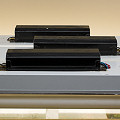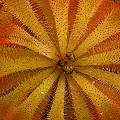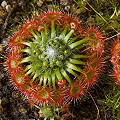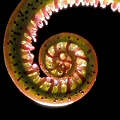Q: About light quality.
A: All light is not the same as far as plants are concerned. In order to
photosynthesize (i.e. make food), plants need light
of the correct wavelengths. You can slam a plant with all the photons you want, but if they are of the
wrong kind, the plant can't use them.
It would be like trying to feed grass to a lion, or clumps of mud to your little sister. (Except in the
latter case, at least it would be fun.)
The kind of light that plants require is called "photosynthetically active radiation", or
PAR. Sunlight is rich in PAR; if you are growing your plants under adequately bright sunlight, the
quality of the light is fabulous.
If, however, you are using artificial lighting, you must indeed worry about the
quality of the illumination from your light source.
The most valuable wavelengths are primarily in the short to midrange (blue through orange) parts of
the visible spectrum. Lighting specialists claim that the orange and red portion of the spectrum
enhances budding, flowering, and fruiting while the blue end of the spectrum
encourages strong vegetative growth, but that might be information specific only to certain...crops (see the last
paragraph below to decode what I mean).
Immediately rule out the idea of using incandescent lighting. Incandescent lights are the classic light bulbs
of the kind that appears over the heads of cartoon characters when they get ideas.
Incandescent lighting is useless for carnivorous plant horticulture because it contains a large
amount of heat and very little PAR. (In other words, the spectrum from incandescent bulbs is weighted too much towards the infrared.)
These bulbs will only cook your plants. Not good.

Six bulbs of ballasts
You should probably use fluorescent bulbs. Having a strong intensity light source is more important than having a wide
range of wavelengths, so the specialty "full spectrum" and "grow light" bulbs that cost so much are
not worth the money. Instead, use standard bulbs. In the USA, they are marketed with names such as "cool white"
or "warm white". These also go by the names "kitchen and bath" or "shop-lites". It doesn't
matter which of these you get---I like a mix of about 4 cool-whites and 2 warm-whites because the light spilling from my
terraria make a nice illumination for the humans also in the room.
When buying bulbs, I buy T12 bulbs and make sure they are 40W bulbs instead of the lower power rating 34W that are
(if I recall correctly) available for T8 bulbs. It is important, of course, to buy the correct fixtures---don't try to install
T8 bulbs in a T12 fixture.
I recommend that you buy fluorescent bulbs made by lighting companies such as G.E., Phillips, Sylvania, and others like that.
Fluorescent bulbs made by hardware stores are usually cheap, and don't produce as much light. They may start off fine, but in a
few months they drop significantly in output.
When buying fluorescent fixtures, look for ones with electronic ballasts as they are better than the magnetic ballasts.
Electronic ballasts are more energy efficient which is good for both your bank account and also your plants (which don't want
to be cooked by the heat from the wasteful magnetic ballasts). For more about ballasts, look at my terrarium
building guide in the FAQ library.
Do not use ultraviolet lamps, also known as black lights. Apparently these have some use in the reptile trade, but they are not
appropriate for carnivorous plants.
Some growers like to use exotic, high intensity discharge (HID) bulbs. These can be extremely bright, but are equally expensive.
Metal halide (MH) bulbs produce a nice blue-white light chocked with PAR, but may be prohibited in areas near astronomical
observatories. The reason for this is that they cause light pollution that astronomers cannot easily filter from their data.
High pressure sodium (HPS) lights produce most of their radiation near 589 nanometers, which while in the range of PAR, may
cause leggy growth (so I have read on-line). Because of this, HPS should not be used alone--use them to supplement sunlight or MH illumination.
Some HPS lights are enhanced to produce more light in the blue wavelengths, making them
more suitable for use without MH bulbs or sunlight. Low pressure sodium vapor lights have a spectral range even more
concentrated at 589 nanometers.
There are a few other specialty illumination sources that are extremely expensive, and I think are built in Germany. I know some growers
are using these with success,
but I haven't explored this to any great depth. Oh, and the devices called something like Phototrons are a huge
waste of money as far as I'm concerned. Just make a friggin' terrarium and you'll have far more growing area for far less cost.
It may be of interest that in the USA, extremist efforts by the Drug Enforcement Agency has led to their confiscating the
customer records of companies that sell HID bulbs, because they think that users of such lights are likely to be growing
illegal crops. (Indeed---much of the best lighting information is available from web sites dedicated to marijuana growing!).
Make sure that you keep your nose clean, because in their fervor the D.E.A. has been known to confiscate entirely legal
collections of orchids! This bizarre miscarriage of justice was carried out under the name "Operation Green Merchant"
during the 1980s.
Page citations: Rice, B.A. 2006a; personal observation and web sites
I don't care to cite.



